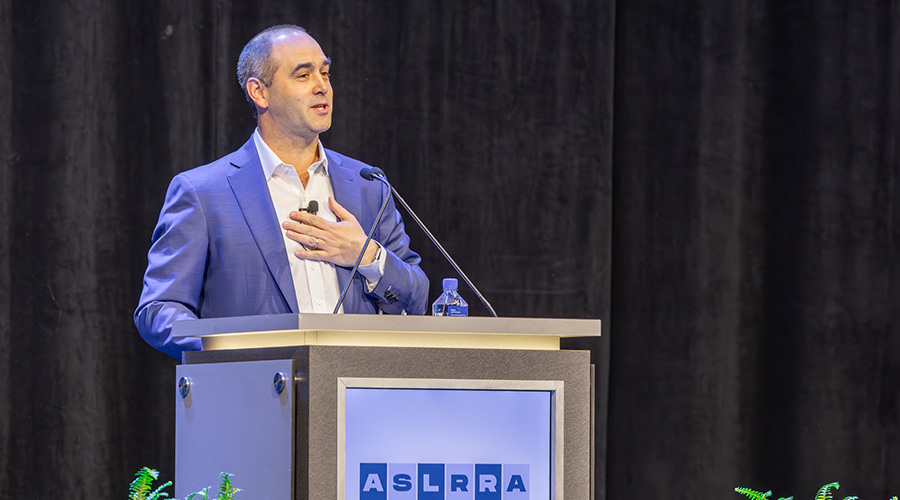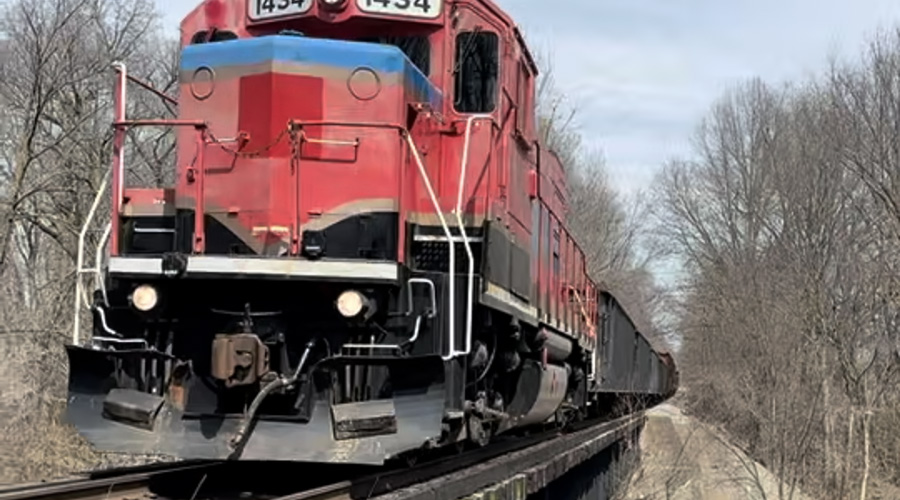Notable and quotable: Intriguing comments from ASLRRA's annual meeting in K.C.
4/5/2024
By Jeff Stagl, Managing Editor
During its annual meeting and exhibition in Kansas City, Missouri, the American Short Line and Regional Railroad Association (ASLRRA) as usual conducted a general session the morning of the first full day of activities, in this case March 25.
But there was something that wasn’t all that usual throughout the presentations that lasted more than three hours: There were quite a few noteworthy and thought-provoking comments made by several speakers.
That was apparent soon after ASLRRA President Chuck Baker addressed a large crowd in a Kansas City Convention Center ballroom near the beginning of the general session. He first shared that the annual convention had attracted more than 1,800 attendees — the annual event’s third-highest-ever attendance — garnered 265 exhibitors and offered 40 breakout sessions divided into14 separate learning tracks.
 ASLRRA President Chuck Baker underscored the need to update and modernize Section 45G, or the railroad track maintenance tax credit for short lines. American Short Line and Regional Railroad Association
ASLRRA President Chuck Baker underscored the need to update and modernize Section 45G, or the railroad track maintenance tax credit for short lines. American Short Line and Regional Railroad AssociationBaker then underscored one of the association’s primary lobbying efforts, which calls for updating and modernizing Section 45G, or the railroad track maintenance tax credit for short lines. The measure provides regionals and short lines a 50-cent tax credit for each dollar spent on track rehabilitation and maintenance work up to $3,500 per mile of track they own or lease.
The federal Consolidated Appropriations Act of 2021 made 45G permanent in late 2020, but the $3,500 per mile of track stipulation is very outdated, Baker said. Small roads’ track maintenance and construction costs have rapidly increased since the tax credit was created nearly 20 years ago.
“It was $3,500 per mile when 45G started in 2005 and it’s still that same amount today,” Baker said. “It’s time to update it from $3,500.”
In addition, 45G — which has driven more than $5 billion in private investment since its inception — doesn’t cover rail that was built or acquired after Jan. 1, 2015.
After his address, Baker posed questions to Surface Transportation Board (STB) Chairman Martin Oberman and member Patrick Fuchs in a fireside chat-style panel. Responding to a question about growth in the rail industry, Oberman said he has grown weary of the “pivot to growth” comments from Class Is of late. Instead, he finds small railroads approach to it refreshing.
“You don’t hear ‘pivot to growth’ at a short-line conference,” Oberman said. “The short lines already are growing.”
 From left to right: ASLRRA’s Baker posed questions to STB Chairman Martin Oberman and STB member Patrick Fuchs. American Short Line and Regional Railroad Association
From left to right: ASLRRA’s Baker posed questions to STB Chairman Martin Oberman and STB member Patrick Fuchs. American Short Line and Regional Railroad AssociationLater during the general session, Canadian Pacific Kansas City Executive Vice President and Chief Marketing Officer John Brooks addressed Oberman’s comment.
“We are not pivoting to growth. We are in full growth mode,” Brooks exclaimed.
CPKC — which will mark its first anniversary in April — has been growing business even while Canadian Pacific and Kansas City Southern integrated their organizations over the past year, he said.
 Canadian Pacific Kansas City EVP and CMO John Brooks said annual revenue is generated by three major sources: intermodal, carload business and grain/auto traffic. American Short Line and Regional Railroad Association
Canadian Pacific Kansas City EVP and CMO John Brooks said annual revenue is generated by three major sources: intermodal, carload business and grain/auto traffic. American Short Line and Regional Railroad AssociationThe railroad also has generated $350 million in synergies over the past year “because we’re unique,” said Brooks, referring to CPKC being the only Class I with a network through Canada, the United States and Mexico that requires no interchanges with other large roads and offers seamless border crossings.
CPKC generates one-third of annual revenue from intermodal, one-third from carload business and one-third from grain/auto traffic. Efforts to boost intermodal business resulted in diverting more than two times the number of trucks off highways that was forecast — 64,000 — in CPKC’s first year, said Brooks.
Intermodal business has received a boost from the Mexico Midwest Express (MMX) premium service launched last year. MMX is the first and only single-line service between Mexico and the U.S. Midwest, offering dedicated daily intermodal trains with the fastest transit times in the rail industry, said Brooks.
 The Staggers Rail Act of 1980 is in desperate need of an update, said STB Vice Chair Karen Hedlund. American Short Line and Regional Railroad Association
The Staggers Rail Act of 1980 is in desperate need of an update, said STB Vice Chair Karen Hedlund. American Short Line and Regional Railroad AssociationThe truck-like service can provide transit times that are “better than single-driver trucks,” he said, adding that MMX provides a seamless and expanded reach to more markets.
However, despite some early successes, the new Class I “didn’t get it all right” since the merger, Brooks shared. CPKC President and CEO Keith Creel believes the organization only rates a “C” grade so far.
“He’s a tough grader,” said Brooks. “All the low-hanging fruit has been picked. We need to continue to develop and introduce more unique services.”
For STB Vice Chair Karen Hedlund, there’s a strong need to continue ensuring a longstanding and vital piece of rail legislation remains relevant. The Staggers Rail Act of 1980 desperately needs an update, she said during her address.
“We have to tweak Staggers. It’s time,” Hedlund stressed.
She believes that revised regulations or new legislation must recognize that the structure of the Class I network has changed dramatically in the years since the Staggers Act was enacted. Now, there are only six large railroads that are generally configured into a set of “tripartite duopolies,” with two in the East, two in the West and two that are primarily North/South operators, said Hedlund.
“Staggers admittedly saved the railroads from an accelerating downward spiral, and did so by intentionally paving the way for mergers that have yielded the six extremely profitable Class I common carriers we have today. Perhaps it’s time for the statutory pendulum to swing the other way,” she said.
Although it seems unlikely the legislative branch will make significant statutory changes anytime soon, Hedlund hopes her stance will at least help to foster and/or further a conversation about such changes.
Since the lively commentary riveted the crowd in K.C., here’s hoping some equally compelling comments are shared during the general session at the ASLRRA’s next annual conference. It’s scheduled for April 6-8, 2025, in Denver.


